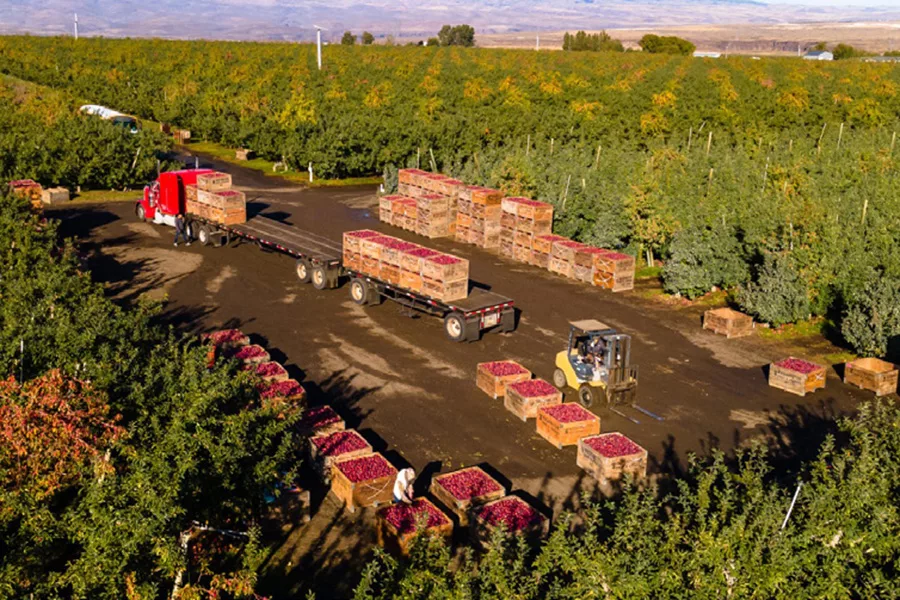
Home » Another large crop could add pressure to crowded market
Apple overload
Another large crop could add pressure to crowded market

Washington has been producing large crops of apples in the past few years, bringing a share of market challenges. Above, Red Delicious apples are loaded post-harvest.
Courtesy Washington Apple CommissionJune 12, 2025
Washington followed up its second-largest apple crop in 2023 with a harvest nearly as big in 2024, and early signs point to another strong crop in 2025. But for growers, another large harvest brings as many challenges as opportunities.
The 2024 harvest amounted to 132.4 million 40-pound boxes of apples, or bushels, down roughly 3% from 2023’s whopping 136.4 million boxes. The 2024 apples are still being sold, so that number could change as the season winds down.
The coming growing season appears to be off to a good start as well as far as quantities go. April’s apple bloom was big and growing weather has been cooler so apples may be a little smaller than usual, said Michael Schadler, president of the Washington Apple Commission.
Growers must thin out the blooms on their trees to get the fruit the right size to meet demand, Schadler said, and a year like this makes that process more challenging.
Excessive rain events and heat in July and August also can affect fruit quality, he said.
With an oversupply of apples and prices down, a large crop won’t be doing growers any favors. Costs of production continue to rise as well.
“It’s a squeeze, right?” Schadler said. “We’re kind of taking it from both ends, and it’s a very, very challenging time for growers.”
One thing that might help is reducing the total acreage to lower the supply, but it’s a slow process and one that’s hard on individual growers, even if it has a positive effect on the market. Increased demand, with people eating more apples, also would help boost the industry, said Schadler, who is the new president of the commission.
He replaced Todd Fryhover, who retired in November 2024 after 18 years with the agency.
Schadler, who grew up in the Seattle area, had been with the commission for about eight months as of mid-May. He began working in agriculture 20 years ago with a consulting firm in the Seattle area and most recently served as the executive vice president for the Florida Tomato Exchange, Florida Tomato Growers Exchange and Florida Tomato Committee.
Tariffs and trade barriers
Washington produces about 70% of the apples grown in the U.S., and 30% of them are exported.
In years with smaller apple crops, that export percentage goes down to meet U.S. demand first, but in years with larger crops, exports become more important, Schadler said.
That means that rapidly changing tariffs and international relations present both challenges and opportunities for Washington’s growers.
Ongoing tariff disputes with China won’t have much effect on the apple export market as this market has been slow for Washington apples since retaliatory tariffs were implemented in a 2018 trade war, Schadler said.
“Everybody’s kind of been conditioned to the fact that the Chinese market is going to be tough, probably for a long time, if not forever,” he said.
More concerning would be if Canada or Mexico decided to level tariffs aimed at U.S. apples. The two countries make up over 50% of Washington’s apple exports.
But there’s the potential for positive outcomes from ongoing negotiations, Schadler said. Renegotiating tariffs and non-tariff trade barriers – like strict regulations – could open up key markets for Washington apples.
For example, Washington used to ship over a million boxes of apples to the United Kingdom each year, and now that number has shrunk to less than 50,000 due to the country’s regulations. Schadler said that a trade deal with the U.K. could offer a chance to reduce trade barriers.
Schadler also cited India’s high tariffs on U.S. apple imports and non-tariff trade barriers in Japan, South Korea and Australia as barriers that could be reduced through negotiations, potentially opening these markets up to apples.
Apple industry adapts
While tariffs and trade relations can shift fast, it’s more difficult for the tree fruit industry to adapt.
“You got to have a lot of foresight if you’re going to change production, and then once you change it, it’s multiple years before that tree actually bears fruit,” Schadler said.
But despite the difficulties of change and the impact on individual growers, Washington’s apple industry remains important to the state’s economy. Growers exported $845 million in apples in 2024, up 24% over the prior year, with Mexico, Canada and Taiwan making up the top three markets.
“We’re a big industry,” Schadler said. “We have one of the best growing regions in the world. We’re going to be here for a long time.”
Organizations like the Northwest Horticultural Council based in Yakima work with the U.S. government on behalf of the industry to help reduce trade barriers and tariffs as negotiations continue.
Cosmic Crisp continues to be an exciting variety across the country and throughout the world, Schadler said. And it’s not just an apple that consumers enjoy – it’s also easier to grow than the Honeycrisp, one of the most popular varieties.
And by 2029, Washington State University’s latest apple, named Sunflare after a public contest, is expected to hit grocery store shelves.
“I think most people would say we’re probably growing the best apples that we’ve ever grown,” Schadler said.
Agriculture + Viticulture
KEYWORDS June 2025
Related Articles
Related Products





